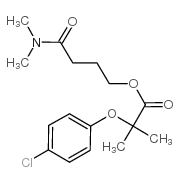CHEMICAL IDENTIFICATION
-
RTECS NUMBER :
-
UE9458000
-
CHEMICAL NAME :
-
Propionic acid, 2-(p-chlorophenoxy)-2-methyl-, ester with 4-hydroxy-N,N-dimethylbutyramide
-
CAS REGISTRY NUMBER :
-
26717-47-5
-
LAST UPDATED :
-
199612
-
DATA ITEMS CITED :
-
5
-
MOLECULAR FORMULA :
-
C16-H22-Cl-N-O4
-
MOLECULAR WEIGHT :
-
327.84
-
WISWESSER LINE NOTATION :
-
GR DOX1&1&VO3VN1&1
HEALTH HAZARD DATA
ACUTE TOXICITY DATA
-
TYPE OF TEST :
-
LD50 - Lethal dose, 50 percent kill
-
ROUTE OF EXPOSURE :
-
Oral
-
SPECIES OBSERVED :
-
Rodent - rat
-
DOSE/DURATION :
-
2485 mg/kg
-
TOXIC EFFECTS :
-
Behavioral - muscle contraction or spasticity Lungs, Thorax, or Respiration - cyanosis Lungs, Thorax, or Respiration - respiratory depression
-
REFERENCE :
-
JETOAS Journal Europeen de Toxicologie. (Paris, France) V.1-6, 1968-72. For publisher information, see TOERD9. Volume(issue)/page/year: 5,239,1972
-
TYPE OF TEST :
-
LD50 - Lethal dose, 50 percent kill
-
ROUTE OF EXPOSURE :
-
Intraperitoneal
-
SPECIES OBSERVED :
-
Rodent - rat
-
DOSE/DURATION :
-
1175 mg/kg
-
TOXIC EFFECTS :
-
Behavioral - muscle contraction or spasticity Lungs, Thorax, or Respiration - cyanosis Lungs, Thorax, or Respiration - respiratory depression
-
REFERENCE :
-
JETOAS Journal Europeen de Toxicologie. (Paris, France) V.1-6, 1968-72. For publisher information, see TOERD9. Volume(issue)/page/year: 5,239,1972
-
TYPE OF TEST :
-
LD50 - Lethal dose, 50 percent kill
-
ROUTE OF EXPOSURE :
-
Oral
-
SPECIES OBSERVED :
-
Rodent - mouse
-
DOSE/DURATION :
-
1080 mg/kg
-
TOXIC EFFECTS :
-
Behavioral - muscle contraction or spasticity Lungs, Thorax, or Respiration - cyanosis Lungs, Thorax, or Respiration - respiratory depression
-
REFERENCE :
-
JETOAS Journal Europeen de Toxicologie. (Paris, France) V.1-6, 1968-72. For publisher information, see TOERD9. Volume(issue)/page/year: 5,239,1972
-
TYPE OF TEST :
-
LD50 - Lethal dose, 50 percent kill
-
ROUTE OF EXPOSURE :
-
Intraperitoneal
-
SPECIES OBSERVED :
-
Rodent - mouse
-
DOSE/DURATION :
-
960 mg/kg
-
TOXIC EFFECTS :
-
Behavioral - muscle contraction or spasticity Lungs, Thorax, or Respiration - cyanosis Lungs, Thorax, or Respiration - respiratory depression
-
REFERENCE :
-
JETOAS Journal Europeen de Toxicologie. (Paris, France) V.1-6, 1968-72. For publisher information, see TOERD9. Volume(issue)/page/year: 5,239,1972 ** REPRODUCTIVE DATA **
-
TYPE OF TEST :
-
TDLo - Lowest published toxic dose
-
ROUTE OF EXPOSURE :
-
Oral
-
DOSE :
-
14 gm/kg
-
SEX/DURATION :
-
male 7 day(s) pre-mating female 7 day(s) pre-mating female 1-22 day(s) after conception
-
TOXIC EFFECTS :
-
Reproductive - Effects on Newborn - stillbirth
-
REFERENCE :
-
JETOAS Journal Europeen de Toxicologie. (Paris, France) V.1-6, 1968-72. For publisher information, see TOERD9. Volume(issue)/page/year: 5,239,1972
|
